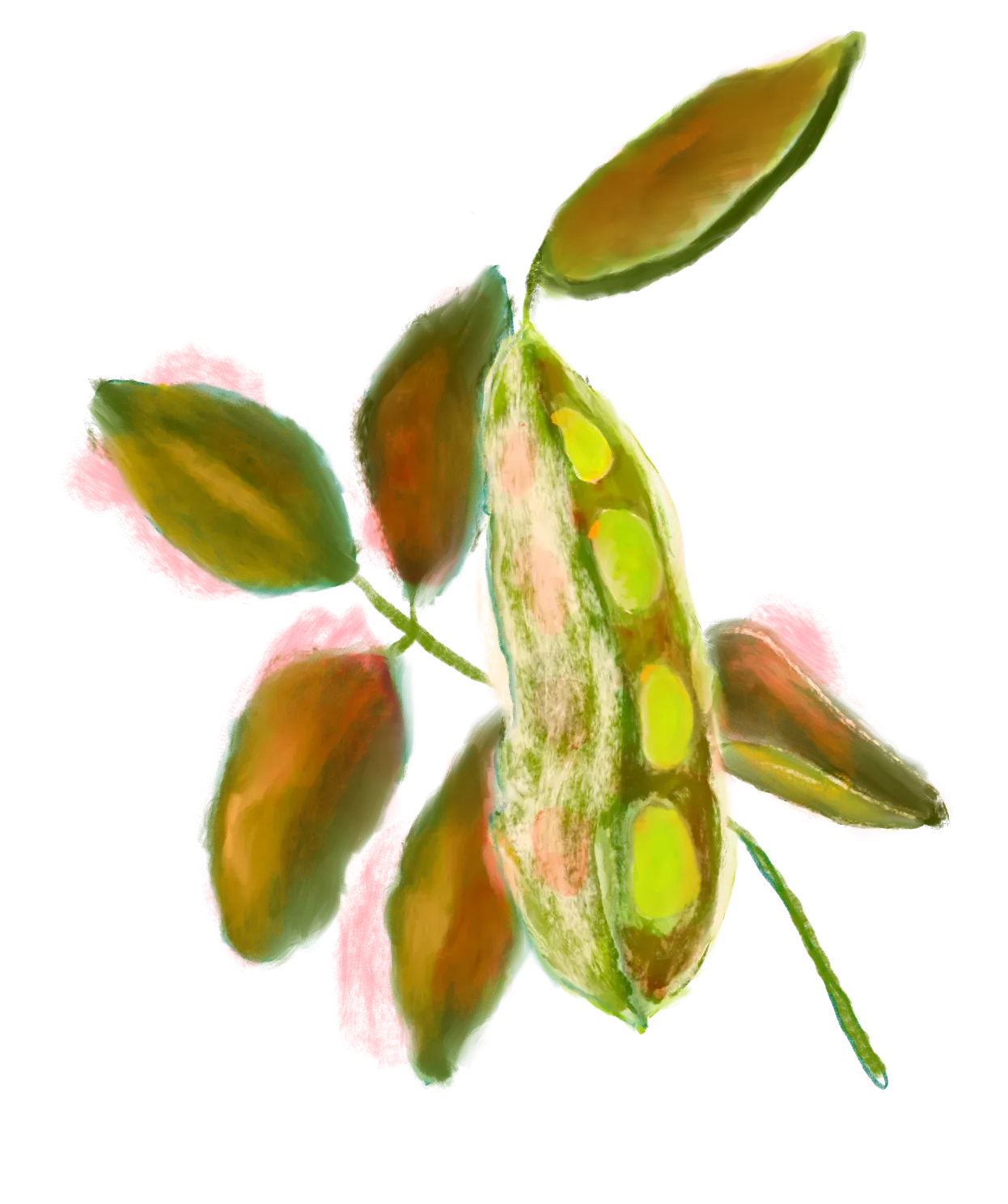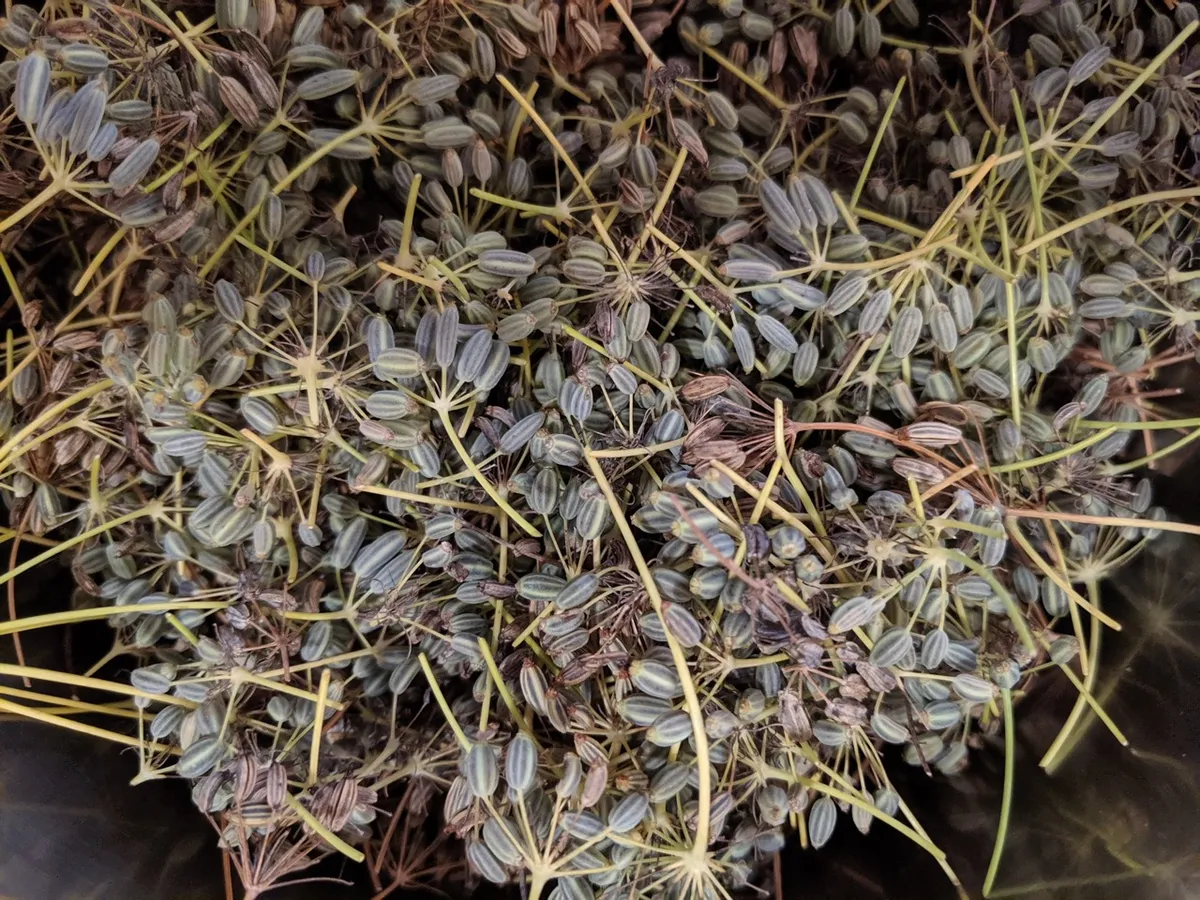Who would have guessed that one of the first vegetables I grew would become such a long-lasting gift in the garden?
The plant that I grew in my first-year garden was fennel. I love adding fennel bulbs to soups and stir-fries, and I was excited to finally be able to grow my own.
But the bulbs from that first crop weren’t very big, so I never actually harvested them. I figured I’d see if they’d continue to grow. So I mulched them heavily for the winter, and in the spring was pleasantly surprised to see that they had stuck around.
As spring turned into summer, my fennel bulbs were no longer bulby…instead, they were increasingly stalky, towering to great heights. They put on a beautiful display of sunshine-yellow pollen that the bees and wasps appreciated.
Then, that autumn, I realized I was growing fennel seeds!
As someone who loves all things licorice-anise, I was pretty delighted by this “aha” moment. I now harvest a couple pint-sized jars of fennel seeds each year to add to teas and as a seasoning for dinners. They lend a sense of warmth and savoriness to meals, and boast some unique health benefits, too.
What I didn’t realize is that I was growing something that is rapidly gaining in popularity.
A few years ago, fennel seeds were not widely known in the United States — except by those of certain ethnic backgrounds, such as Italian or Indian. But now there is an increasing demand for this gem of a seasoning.
In fact, in 2024 the market was valued at $734 million USD, and it’s expected to grow to $1.21 billion USD by 2030 (Research and Markets)!
In this guide, I'll walk you through the surprisingly simple process of growing and harvesting your own fennel seeds. Plus, I'll share some insider tips to help you sidestep the most common pitfalls along the way. Don’t let those seeds on your fennel plant just sit there! Do something wonderful with them instead!
Why Harvest Fennel Seeds?
Amazing Flavor
Fennel seeds offer a distinct flavor profile that elevates your meals and teas.
As I chew on a fennel seed right now, I'm drawn to its warm, earthy fragrance, reminiscent of anise and real licorice — not the candy kind like Twizzlers. The taste has sweet undertones and a surprising 'brightness,' with just a hint of spice, but nothing too intense. For me, it's a comforting flavor, akin to being wrapped in a cozy blanket by the fire with a good cup of tea, watching Lord of the Rings on a rainy day.
You may have tasted fennel seeds in these foods:
Save Money
Growing your own organic fennel seed is an excellent way to save money while stocking a robust spice cabinet.
While it’s always less expensive to buy your dried herbs and spices in bulk, it’s even cheaper to grow them yourself.
Health Benefits
Lots of research has been released lately about the health benefits of fennel seeds in particular.
- intestinal health: A 2022 study showed fennel seed extract can support the tissue of the intestines, which may be helpful for people with inflammatory bowel disease.
- menopause: Research from a study conducted in 2020 found that fennel seed powder helped reduce uncomfortable symptoms of menopause.
- osteoarthritis: In a double-blind trial, women with knee osteoarthritis who were given a fennel seed extract capsule showed a higher amount of relief from pain and mobility issues compared to the placebo group.
- tooth decay: Chewing fennel seeds after a meal was shown in this study to increase the pH of saliva in a way that could reduce tooth decay.
Beyond these studies, fennel seeds have been cherished in various cultures for centuries. In Ayurveda and traditional Chinese medicine, they are valued for their perceived digestive benefits and soothing properties.
Fennel seeds are commonly used in teas, tinctures, and culinary dishes across the world to add flavor and potentially support well-being.
While science continues to explore their full potential, fennel seeds remain a beloved spice with a rich history and a promising future.
Things I Wish I Knew Before Starting
Here are some mistakes I’ve made before when harvesting fennel seeds, and some other misconceptions I’ve heard:
- Waiting too long to harvest seeds: There’s kind of a goldilocks window when harvesting fennel seeds. Timing is everything to get it “just right.” too green and the flavor isn’t developed, plus the seeds are too moist to store for long periods of time. Too old and the flavor profile is a bit off, dry, and there’s a higher chance of mold being on the seeds. Last year, I sadly missed a second harvest window for fennel seeds because I let them sit on the stalk for too long, and they got gray and unappetizing.
Here’s a visual guide I made to show when fennel seeds are ready to harvest:
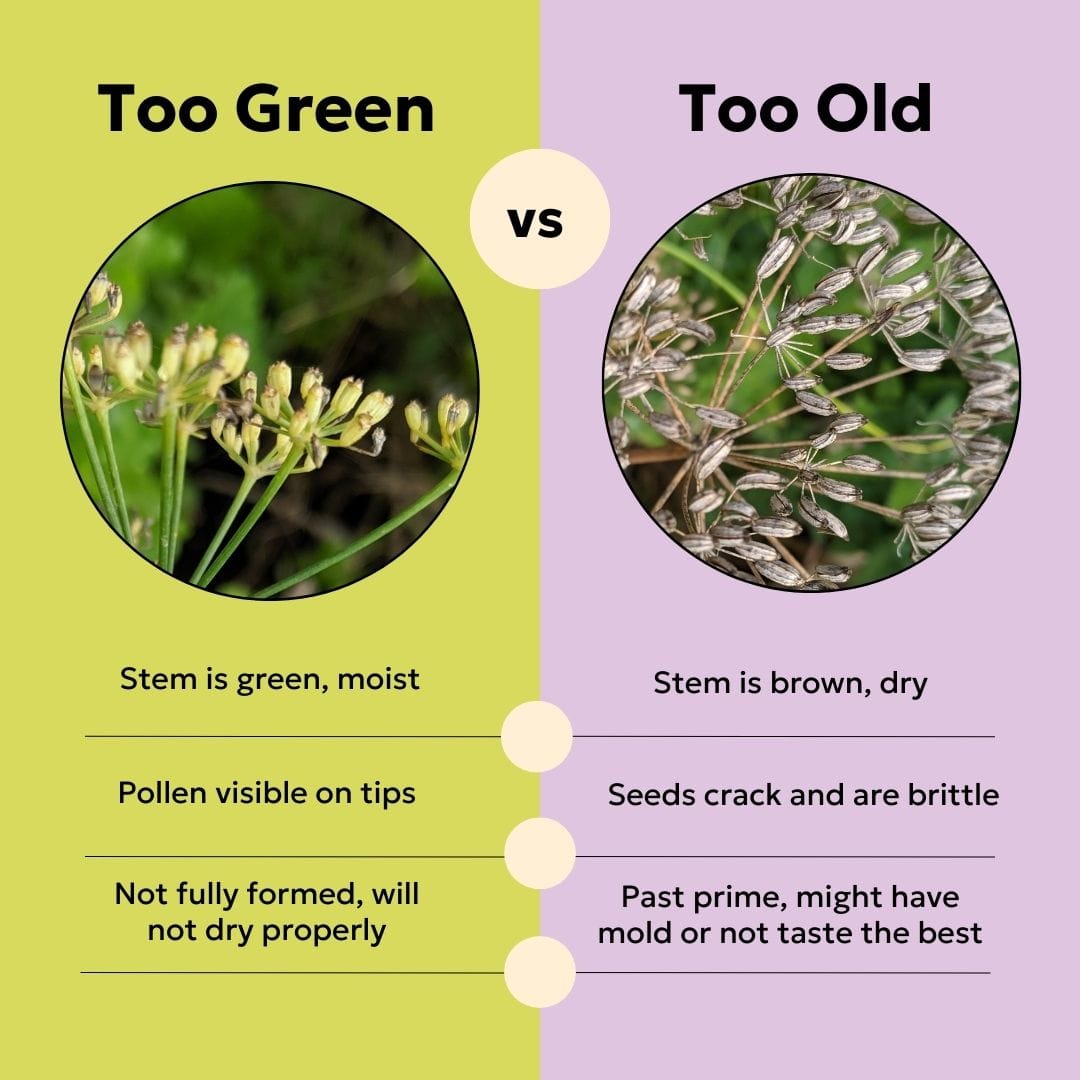
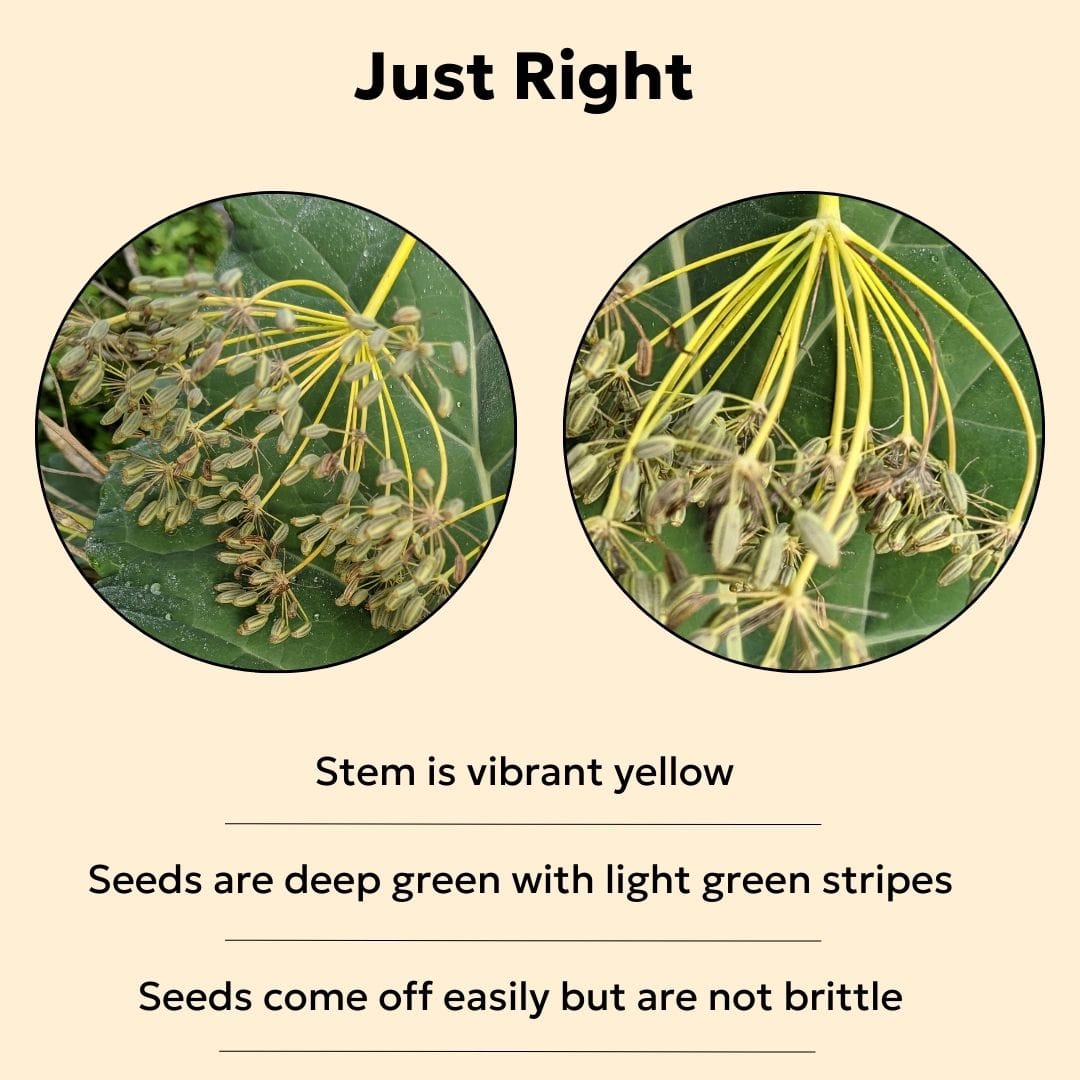
- Waiting too long to process seeds: A few years ago, I left a (albeit small) harvest of fennel seeds, still attached to their stems, in a bowl for a couple of weeks. Since there was no air flow in the bowl, everything got moldy. It was pretty disappointing, but luckily I had already harvested and processed another batch!
- Leaving old seeds on the plant: I’ve learned that unless you want a forest of fennel, don’t leave any old seeds on the plant. Instead, at the end of the season cut back the fennel stalks and give them to your chickens, toss them in your woodstove, or compost the stalks while throwing the spent seed away. Fennel has a tendency to spread in an invasive way, and I’ve spent more time than I’d care to weeding out unwanted fennel seedlings in my garden after carelessly tossing some fennel stalks, seeds still attached, into a “chop and drop” type pile in a raised bed.
- Not fully drying seeds before storage: One year I thought that I had properly dried out my fennel seeds - but then a few months later, I found that my seeds had some mildew forming in the jar. Since then, I’ve spread out my seeds on a sheet pan in the oven on the lowest setting to dry out for an hour. This has prevented any issues with storage viability!
Here’s a quick summary of best practices:
- Place your processed seeds in a food dehydrator or in the oven on the lowest setting for an hour before storing in glass jars to prevent mold.
- Process your seeds within a day of harvest.
- Don’t harvest your seeds when they are too green or too gray-brown. Look at your fennel seeds and find ones attached to stems that are yellow instead of bright green or brown.
- Don’t let your fennel plant spill seed all over your garden; be a good steward to avoid a fennel invasion.visual guide with best practices for harvesting fennel seeds
Throw some appreciation into the tip jar if this resource helped you 🫙
The Harvesting Process: Step-by-Step
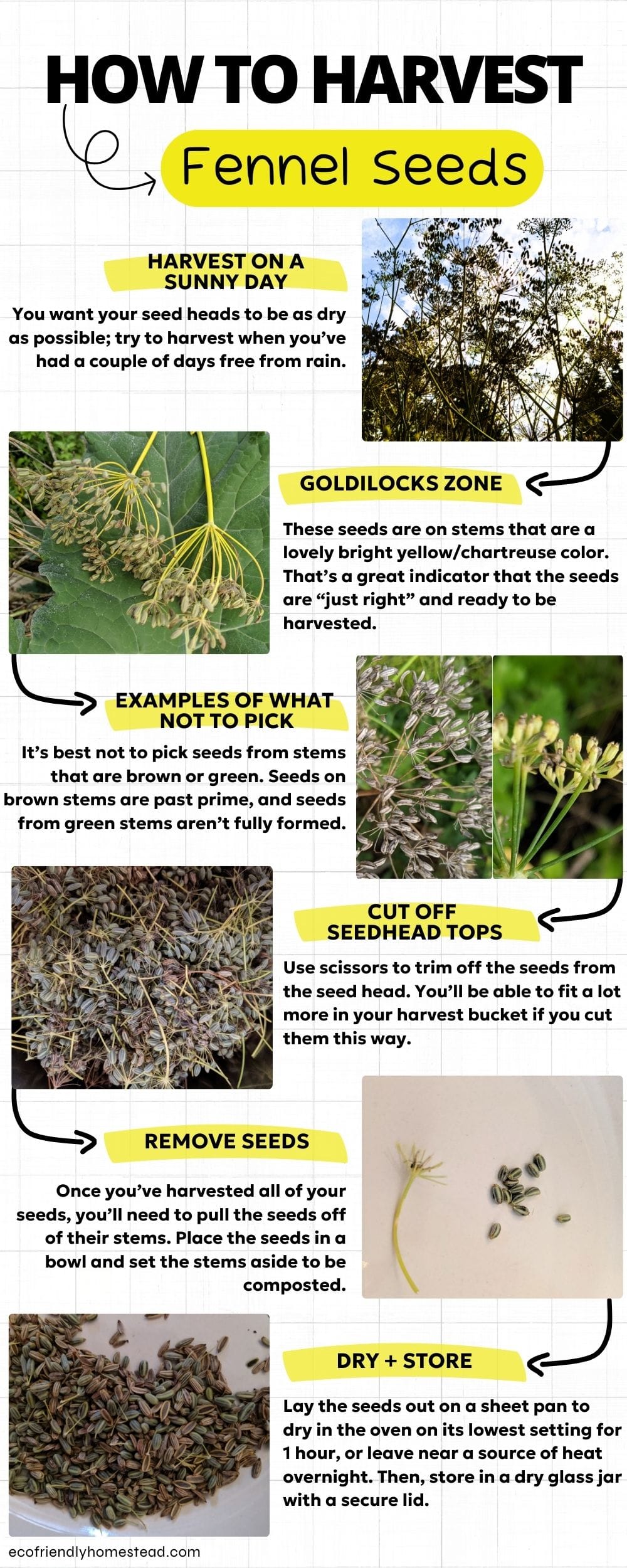
Materials Needed:
- Scissors
- Cooking pot with a handle on it
Best Practice for Efficiency:
- Hold the pot handle in your arm pit so that both of your hands are free to bend down the tall fennel stalk and cut off the seed head with scissors. I’ve found this technique to work really well!
- Trim the seed head just above the seeds so that you can fit more in your pot.
Process:
- Look for fennel seed heads that have the signs of being ready for harvest: seeds are greenish-brown and attached to yellow stems on the seed head.
- Cut the seed head mid-way down the stems, let the seeds fall into your pot.
- Continue on until your pot is full of fresh fennel seeds.
- Keep in a dry spot away from other animals until you process them. It’s best to process within 24 hours of harvest.
Post-Harvest Processing
- Separate seeds from stems: Put on some good music and start to separate your seeds from the stems. I like to have a bowl to put the seeds into, and usually make a pile of stems on the counter where I’m working. I’ll place these stems into the compost pile when I’m done. Be sure to remove all of the stem, otherwise you’ll find them in your meal and think they are spiders.
- Dry: Spread your fennel seeds out onto a sheet pan lined with parchment paper (this will make it easy to transfer into a jar later on). Place in your oven on the lowest setting. Ideal temperature is 100, anything over that will require you to leave the oven door ajar slightly in order to not cook the seeds. Stir occasionally for a total of 1 hour. If you have a wood stove, you can place the sheet pan on a shelf or rack above it over night to get a similar effect.
- Store: Use the parchment paper like a funnel to pour the fennel seeds into clean and dry glass jars. Cover with a lid and keep in a dry place out of direct sunlight.
- Shelf Life: I’ve been able to keep fennel seeds fresh for over a year.These are delightfully tasty!
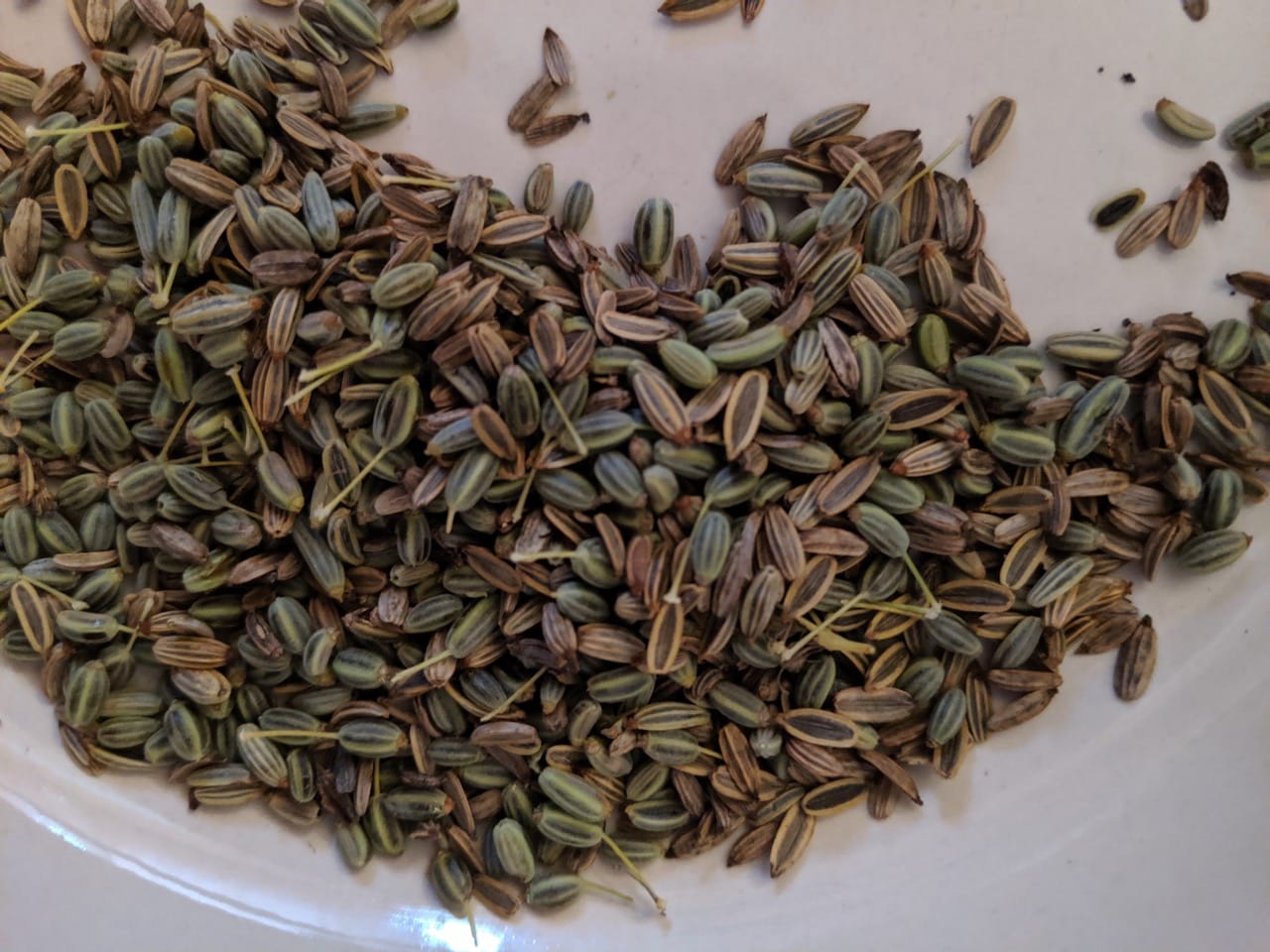
How I Use Fennel Seeds in Everyday Life
- Tea: I’ll add fennel seeds to teas that I’m making for myself or my husband, especially if one of us has a stomach ache or a cold. For me, the tea offers a soothing quality - like the fennel seeds have absorbed all of the warmth of summer’s sunshine and preserved it for me to enjoy over winter.
- Stir-fries: Once I’ve browned my onion and let my garlic cook well, I’ll add fennel seeds along with other spices that I have to add a depth of flavor to stir-fries. Usually a teaspoon is enough to brighten up a meal.
- Biscotti: For something a bit different, I like to add crushed fennel seeds into biscotti dough. For extra effect, I’ll also sprinkle some loosely chopped seeds on top for a savory treat with a unique flavor.
- Broth: When I’m making broth in the Instant Pot, I’ll add some fennel seeds into the mix to provide heaps of flavor.
Other Tips:
- Fennel is a plant that may not produce flowers and seeds until its second year.
- You’ll get a larger harvest if you let the plant overwinter for at least one season.
- In zones 7+, it’s very common for an over-wintered fennel plant to perennialize, so you can get both fennel pollen and fennel seed harvests year after year from the same plant.
- If you live in zones 5 or 6, mulch your fennel heavily with autumn leaves in order to keep it warm and protected over winter. This will increase your chances of your plant surviving into the following spring.
Fennel Seeds: A Unique Flavor Profile
Fennel seeds are a delicious spice with numerous culinary applications. By understanding the techniques, timing, and environmental considerations involved in harvesting, you can make the most of this sweet and savory seed.
Make the most of your perennial fennel plants and prevent their spread: harvest their seeds to enjoy throughout the winter months!
